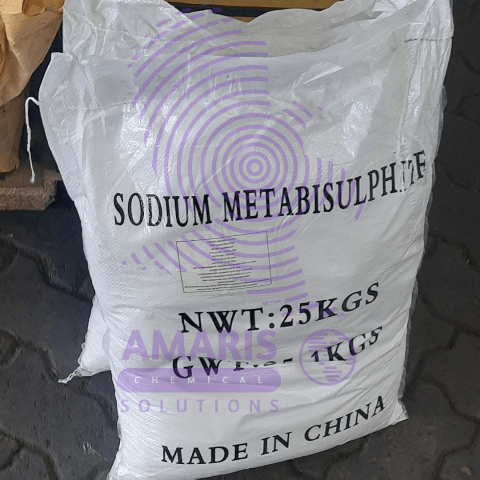Exploring the Benefits of Sodium Metabisulphate in Water Treatment Processes

Sodium metabisulphate (SMBS) is a versatile chemical that plays a significant role in water treatment processes, offering several benefits in maintaining clean and safe water. This compound, with the chemical formula Na₂S₂O₅, is primarily used as a reducing agent, disinfectant, and clarifying agent, making it an essential part of water treatment.
One of the key benefits of sodium metabisulphate in water treatment is its ability to remove chlorine. In municipal water systems, chlorine is commonly used for disinfection. However, excessive chlorine levels can affect water taste and odor. Sodium metabisulphate effectively neutralizes chlorine, ensuring that the water is free of harmful disinfectants without compromising water quality. This makes SMBS a valuable tool in the dechlorination process, especially for industries that require chlorine-free water, such as the food and beverage sector.
Another important application of SMBS is in the removal of heavy metals. It aids in the reduction of toxic metal ions, such as mercury, arsenic, and lead, from contaminated water. By binding with these metals, sodium metabisulphate forms stable, less harmful compounds that can be removed from the water, thus improving its quality and safety.
Moreover, sodium metabisulphate is used as a flocculant in water treatment. It helps in the coagulation and flocculation of suspended particles, making it easier to remove impurities. This process is crucial for both industrial wastewater treatment and the purification of drinking water, where clarity and the removal of particulate matter are essential.
Finally, SMBS is favored for its cost-effectiveness and ease of use. It is relatively inexpensive compared to other water treatment chemicals, making it a popular choice for large-scale operations. Its stability and long shelf life further add to its appeal in various water treatment applications.
In conclusion, sodium metabisulphate is an invaluable chemical in water treatment, offering a range of benefits from chlorine removal and heavy metal reduction to improving water clarity. Its versatility, cost-effectiveness, and efficiency make it a key component in ensuring the safe and clean water supply.


 Emollients
Emollients Humectants
Humectants UV Filters
UV Filters Surfactants (cosmetic)
Surfactants (cosmetic) Preservatives (cosmetic)
Preservatives (cosmetic) Fragrances and Essential Oils
Fragrances and Essential Oils Antioxidants (cosmetics)
Antioxidants (cosmetics)
 Solvents (lab)
Solvents (lab) Chromatography Chemicals
Chromatography Chemicals Microbiology and Cell Culture Reagents
Microbiology and Cell Culture Reagents Biochemical Reagents
Biochemical Reagents Inorganic and Organic Standards
Inorganic and Organic Standards Spectroscopy Reagents
Spectroscopy Reagents Molecular Biology Reagents
Molecular Biology Reagents
 Precious Metal Extraction Agents
Precious Metal Extraction Agents
 Plasticizers
Plasticizers Polymerization Initiators
Polymerization Initiators Stabilizers
Stabilizers Monomers
Monomers Fillers and Reinforcements
Fillers and Reinforcements Antioxidants (plastics)
Antioxidants (plastics) Colorants (plastic pigments,Dyes)
Colorants (plastic pigments,Dyes)
 Fertilizers
Fertilizers Plant Growth Regulators
Plant Growth Regulators Soil Conditioners
Soil Conditioners Animal Feed Additives
Animal Feed Additives Biostimulants
Biostimulants
 Dough Conditioners
Dough Conditioners Flour Treatments
Flour Treatments Fat Replacers
Fat Replacers Preservatives (baking)
Preservatives (baking)
 Surfactants (cleaning)
Surfactants (cleaning) Builders
Builders Bleaching Agents
Bleaching Agents Enzymes
Enzymes Solvents (cleaning)
Solvents (cleaning) Fragrances
Fragrances Disinfectant
Disinfectant Metal cleaning
Metal cleaning
 Binders/Resins
Binders/Resins Pigments
Pigments Solvents (paint)
Solvents (paint) Additives
Additives Driers
Driers Anti-Corrosion Agents
Anti-Corrosion Agents Specialty Coatings
Specialty Coatings Functional Coatings
Functional Coatings Application-Specific Coatings
Application-Specific Coatings
 Sealants and Adhesives
Sealants and Adhesives
 Biodegradable Surfactants
Biodegradable Surfactants Bio-based Solvents
Bio-based Solvents Renewable Polymers
Renewable Polymers Carbon Capture Chemicals
Carbon Capture Chemicals Wastewater Treatment Chemicals
Wastewater Treatment Chemicals
 Preservatives (food)
Preservatives (food) Flavor Enhancers
Flavor Enhancers Acidulants
Acidulants Sweeteners
Sweeteners Emulsifiers
Emulsifiers Antioxidants (food)
Antioxidants (food) Colorants (food)
Colorants (food) Nutrient Supplements
Nutrient Supplements Nutraceutical Ingredients
Nutraceutical Ingredients
 Fresh Herbs
Fresh Herbs Whole Spices
Whole Spices Ground Spices
Ground Spices Spice Blends
Spice Blends
 Surfactants(oil)
Surfactants(oil)
 Antibiotics
Antibiotics Active Pharmaceutical Ingredients
Active Pharmaceutical Ingredients Excipients
Excipients Vaccine Adjuvants
Vaccine Adjuvants Nutraceutical Ingredients
Nutraceutical Ingredients Solvents (pharmaceutical)
Solvents (pharmaceutical)
 Automotive chemicals
Automotive chemicals Pyrotechnic Chemicals
Pyrotechnic Chemicals


 Vulcanizing Agents
Vulcanizing Agents Accelerators & Retarders
Accelerators & Retarders Antidegradants
Antidegradants Reinforcing Agents
Reinforcing Agents Plasticizers & Softeners
Plasticizers & Softeners Fillers & Extenders
Fillers & Extenders Blowing Agents
Blowing Agents Adhesion Promoters
Adhesion Promoters












